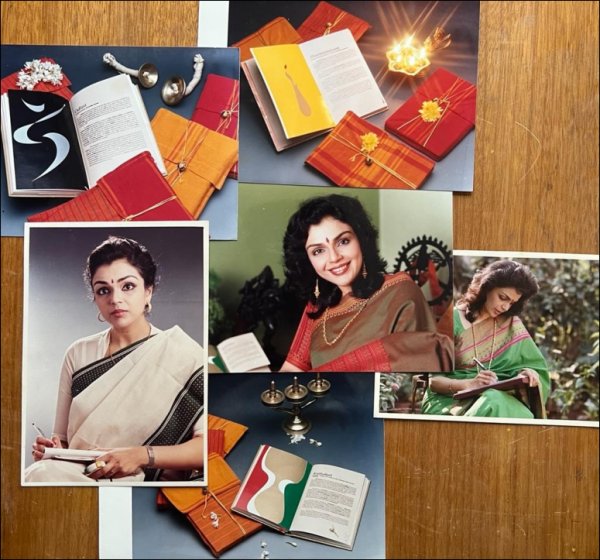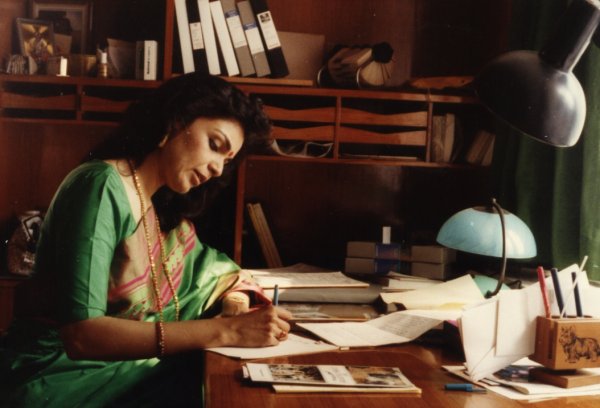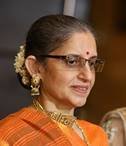
|
 |

|
 |
Anita Ratnam on 30 years of Narthaki - Shveta Arora e-mail: arorashveta1806@gmail.com Pics courtesy: Anita Ratnam August 16, 2022 Narthaki.com, the beloved e-magazine in the world of Indian classical dance, celebrates 30 years in 2022. Its founder, Anita R. Ratnam, was interviewed about it by actress and dancer Padmapriya at a session in Natya Vriksha's World Dance Day celebrations in Delhi this year. In a film screened at the start of the session, Anita described how Narthaki came to be. In 1990, she was a TV producer of Indian content in New York, and was contacted by the American Broadcasting Company. They were doing a series of stories on India and needed the phone number of leading Bharatanatyam exponent Yamini Krishnamurthy. But no one in the Indian embassy had the number, so they approached Anita, who was running the Bombay Broadcasting Company there. Anita called her aunt in Delhi and procured the number within 24 hours, but it struck her that there was no cataloguing of classical dancers' numbers. She was appalled that a dancer as eminent as Yamini Krishnamurthy was not on the list of contacts in embassies or consulates. So she came up with a proposal for a national dance directory. And thus began the journey of Narthaki, initially a phonebook for dancers from all over India. She contacted the culture ministry and got the phone numbers of Indian classical dancers. The first edition, unveiled in 1992, was designed by Swati Bakshi and was given a burnished golden cover. It was dressed in a piece of a dance saree with a ghunghroo as a clasp. At the turn of the millennium, Narthaki went online, beginning its journey to becoming a website - narthaki.com. The site carried information about the classical dance forms of India. There were previews of upcoming events, reports and reviews of the ones gone by, interviews and many informative articles by experts in their fields, and birthdays and obits too. But during the pandemic, two years ago, Narthaki also began to produce and curate online events. A series of short dance videos were commissioned, curated and made into a theme-based production called the Boxed series, which were followed by Devi Diaries and Andal's Garden. Lalitha Venkat and Sumathi are the two diligent pillars of Narthaki, said Anita, and the staunch caretakers who have helped in the rearing of this beauty@30. Below are excerpts from what Anita discussed with Padmapriya and others at the Natya Vriksha WDD session.  Padmapriya interviewing Anita Ratnam Andal's Garden and the curatorial process... It was a huge amount of work. But what we did do was get people from other styles, like Manipuri and Kathak, to perform to Tamil, which for many people was the very, very first time. So looking back, some of it might seem a bit naive when you say that I'm pushing for this, but some of the Indian dance traditions are so set in the language that they work with, the kind of music that they work with, that there's a lot of hand-holding that I did for that one month. It's exhausting. I'd much rather have a team that just takes an idea and runs with it, and I just step back and micro-manage it. But I think that I have an eye for the editing and the timing and the pacing, with my years in the media. I can tell when a dancer is sort of in love with himself or herself and it doesn't need to be as long as they've made it. So I would sit with the editor and say, why don't we end it here, the information is given. The curatorial process is not that we have a curatorial committee. We are thinking about the next series. We've just done a commission, our first full commission, on epic women. We picked six dancers and are giving them a certain amount of money and three months to create a work, first digitally, and then we support them if they want to create the work in real time again, physically. The possibilities in the Indian dance and theatre world are really open. Maybe I am going off topic, but I get very impatient. Dancers are so obsessed with... my fan colour is not right and my back seat is not high enough. I just want dancers to get on with it, like, okay, please look at the aesthetics of your costume, yes, but really, really think of who you are and what your place is in this community. You know, I don't think we even have a true community of dancers. I realized that in 2019 when the MeToo movement erupted in India. Swarnamlaya Ganesh (Sadir exponent, researcher, actress) is here and she led the charge. And I was certainly there amplifying it and I am very proud to say at least the sabhas stood up and blackballed, seven or eight of the musicians who were named. But we found complete silence from other dance communities in India, even when they were known perpetrators. And also the naiveté when we have dance meetings, when we have organizations getting together and dancers getting together, there were comments like, 'But he's not done anything to me, so can I still work with him?' These were questions that people wanted to ask and they needed to be addressed. Because these were questions that dancers felt like asking, either with a musician or with a presenter or with the percussionist or a researcher, and these were real case studies of abuse. But while the shockwaves were happening, Swarnamalya and I found very little resonance, and I don't think we really found enough people in the dance community to stand up and say, yes, this is happening. The musicians were blacklisted and not allowed to perform. But they are all back. I think maybe only one place has not invited them back. But they're all back. The boys' club is very powerful. Narthaki as a space for grievance redressal... I think there has to be one of those closed-door Zoom meetings, you know, rather than on a website, but we've already been in the midst of psychological counselling for several artistes on a one-on-one basis. Depression and mental health issues have been at the forefront during the pandemic. At that time, it seemed that everybody was dancing, because there were dance festivals non-stop for free online. But we don't know about the dark moments that many, many dancers were facing, especially younger dancers. And we completely ignored the rural sector, we completely forgot about the folk artistes and ritual artistes and the temple artistes, many of them were so desperate, they just took their own lives because they couldn't feed their families. So that's what I feel - we live in urban spaces, and most of the time, many classical dancers are rich and privileged. But if we think of that and acknowledge it, what are we doing to our comrades? What are we doing with our colleagues? And that's where we spoke about dance philanthropy - whatever was possible was done. And it's not just dance, it was weaving communities, it was craft community, anybody who had overstocked supplies. I think there were some of us just saying, send, send and buy and help and support. And that's why I feel that as dancers, our sensibilities are really finely tuned, and we really understand what this art is giving us. And if it is finely tuned, then we need to have a certain level of empathy, and acknowledgement or at least recognition of what else is happening around us. We are part of the ecosystem, we are not an island. For a dancer to stand on stage, for that moment, the light person comes on, the costume person has worked, all the musicians are there, and the days and hours of rehearsal, the parents, the family, everybody's come together to put that dancer on stage at that level. So she is not standing on her own. She's standing at the centre of a community that has brought her to that space, to that moment. That is what I want - for dancers to not have blinkers and really think about who they are. I think there is a basic inhibition in India to talk about one's personal life and problems. I had contacted a psychiatrist and a counsellor, and said that if there's anybody who wants help, can I please refer them to you, to talk to them. But after the first conversation, they didn't want to go back. I don't know... maybe the pain is too deep. There's a whole process, I think, about how you talk about oneself. And of course, during COVID, it had to be only on Zoom, you couldn't even meet them in person. So this is an area which I think needs to happen. And we know that there are people who work with arts in the law during the pandemic, because copyright became one of the huge issues that emerged. Finally people realized who is stealing whose music and who is using what and who's using whose choreography and who was cut-pasting. Because, otherwise in the real world we can't police everyone. But then I found that YouTube and people were having the most ridiculous copyright strikes. My own music, created for my productions - there was a strike on it. So the process of copyright law and IP emerged as an important area during the pandemic. And with more and more dancers now using recorded music, I think it's really, really important now for us to acknowledge that there is a way for us to first copyright it. Then if there is a problem, there is a process where you write to YouTube or you write to Instagram, and then they clear it, they unlock it. The very famous Astad Deboo, who has the most amazing music for his productions, always had an agreement with the composers, whether Japanese or Italian or Swiss or French. And we would, of course, watch it live on stage and never think about it. The minute I started putting Astad's works online, the music would be struck out, because there would be a copyright strike on it, saying that this composer or this music company has rights to it. He had the rights for a live performance. So there are issues that emerged during the last two years that can certainly be followed up with. And I really see Narthaki as once again being called collaborative with lawyers and legal experts to be able to highlight some issues. Dancers are already complaining in the Kuchipudi world about those who paid for recordings. How do we resolve it when the Copyright Act says no, you can't use it, but then if somebody's paid for it, and at that point didn't get a release form from the guru...  Balancing her personal brand and Narthaki I think the pandemic helped clarify a little bit of it. I went on an Instagram live stream, and I did 100 live interviews, about everything, including food, fashion, craft, travel, fitness, yoga... things that I was interested in. And a lot of young dancers who followed me and Narthaki on Instagram, I think got introduced to other aspects of life that they knew gave me great joy, and maybe their own world was shifted a little bit. So I don't worry too much about keeping things separate. Because for me, my life and my art go together. It's not a day job. And for that, I'm so, so lucky that my passion is my profession. I have Sonam Dubal sitting here, my dear friend in design; I have a friend, a doctor who's a great art aficionado. And I have friends from the media and other areas of life and I try to include them all in how amazing the world of the live arts is. And that's what I want the younger dancers to do, to be dance advocates, to go out and get somebody from another sphere of activity, not just your own dance group and dancers, because the number of dancers has grown. And Narthaki has grown and become a trusted, beloved global brand. I just feel that dance audiences need to widen. We are still doing it with so much effort - please come, please come... But I know the time when Yamini Krishnamurthy would come to Madras, and it would be like a rock concert. You know, the crowds outside, just trying to get in. Today, we get that for some classical musicians in Chennai. We don't find that excitement in dance. We don't find people thronging the lobby, you know, waiting to catch a glimpse. And one other thing we don't have is we don't have characters. Everybody's sandpapered to a dull, boring, bland sameness. We don't have people like Khushwant Singh or Subbudu. The arts need characters, people who will say things maybe sometimes outrageously, but we need people to infuse that into the arts. In this very politically correct work environment, we are always tiptoeing now, walking on eggshells, worrying about who you're going to offend, who not. Acknowledge your privilege, concede your privilege. It's also because I have the great fortune that it is my space (Narthaki). I started this portal. So I'm never looking for a handout from the government. I'm not stitched to other kinds of tags. I've never been afraid of expressing my opinion, either in other forums or through writing. But one thing is really very clear. The only space in the mainstream is for protest writing. You can't celebrate something; you can't be delighted and grateful for something amazingly beautiful. You have to protest it. You have to rail against something, you have to whine and gripe and point fingers and throw stones and that's the kind of writing that gets published. Nobody wants to hear a dancer's point of view, if they have something positive to say. And that for me is a great lack.  The legacy of nurturing artistes and being a woman running a powerful organization in the arts... This 30-year mark is a moment for me to reflect on that. Because I've always said that the nuts and bolts and physical buildings, and things that my parents initially wanted me to build, my children are not interested in it, I didn't want to burden them with that. But having said that, I myself have so many books and my costumes and my videos, and we're looking for a place. In the whole of India, we don't have a dance museum that we can donate to. So that's something that we have to really think about - we don't have a physical space, even as some of us are looking to digitize our work. I'm also asking myself, what is this legacy, this amazing archive of writing and information and humorous articles, whatever it is, there is such an archive! What are we going to do with this? So the legacy is to see how long can Narthaki, sort of, trundle on, maybe something's going to get lighter, maybe the app will happen. But I think dance is not going to stop, the activity of dance won't stop; the whole activity of teacher and the taught would not stop. What aspect of it is Narthaki going to reflect and refract, what aspects of it will it pick up? At the heart of it, because I'm a dancer and a performer, I think I really believe in that experience of embodied practice. I think Narthaki will always be there to champion a dancer, a performer, a thinker, a choreographer first, and that, for me, is very important. That live arts experience is at the heart of what drives me. I think that it cannot become just academic concept writing, and while that is important, I really think the heart of dance is really what will drive dancers, and dancers will drive Narthaki. Dance writing... It has gone down - the content has gone down, the quality has gone down, the number of writers has gone down. Nobody wants to critique anymore. They just want to praise. So we're looking at the big challenge for us. We're looking for good dance writers. And if nobody wants to review a performance, it's fine. But we need conceptual writing also, about issues that relate to dance. Narthaki is always looking for ways in which to improve. Expanding the Narthaki content portfolio... We need new voices, more voices and more inputs from other parts of India. We could get more voices from other parts of India, especially Kathak - north India feels a bit left out. They don't have enough representation. We have to address all those things. Besides that, we also want to put up information about grants, scholarships, about festivals. We want to help dancers with information which would interest them.  Shveta Arora is a dance-mad writer who chronicles classical dance events in Delhi (and also those online). In 2009, she started the blog Kala Upasana at delhiculturecomment.blogspot.com, where she began posting her own writing along with photographs clicked by Anoop Arora, her husband. She's been dancing all her life as a devotee, but resumed her formal training in Kathak in her 50s and has passed her fifth year Kathak exams. Post your comments Please provide your name and email id when you use the Anonymous / blog profiles to post a comment. All appropriate comments posted with name and email id in the blog will be featured in the site. |